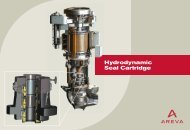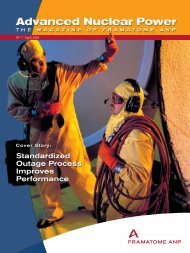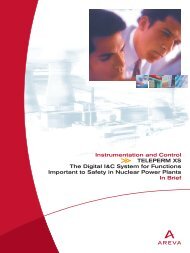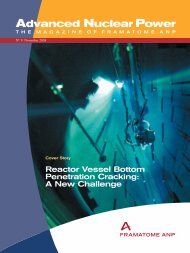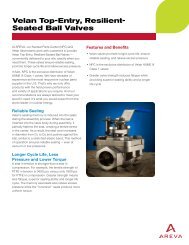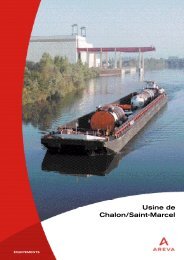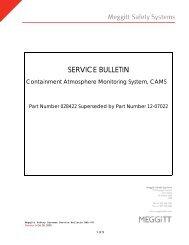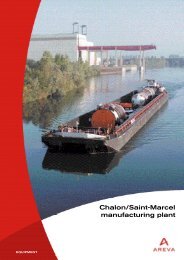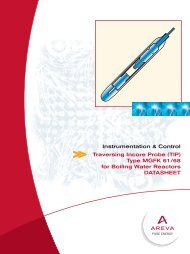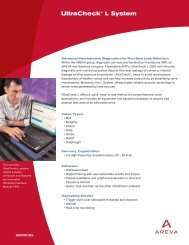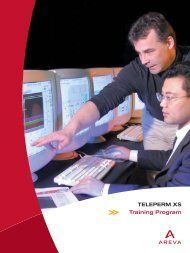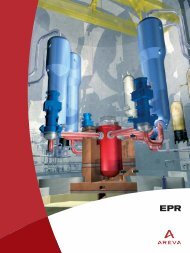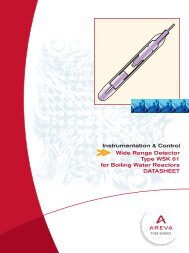Life Cycle Management - AREVA
Life Cycle Management - AREVA
Life Cycle Management - AREVA
You also want an ePaper? Increase the reach of your titles
YUMPU automatically turns print PDFs into web optimized ePapers that Google loves.
Advanced Nuclear Power<br />
T H E M A G A Z I N E O F F R A M A T O M E A N P<br />
N O 6 January 2003<br />
<strong>Life</strong> <strong>Cycle</strong><br />
<strong>Management</strong><br />
The Power<br />
of Experience
C O N T E N T S<br />
Advanced Nuclear Power<br />
N O 6 January 2003<br />
Framatome ANP<br />
Worldwide Offices<br />
Tour Framatome ANP<br />
92084 Paris La Défense Cedex<br />
France<br />
Tel: +33 1 47 96 00 00<br />
Fax: +33 1 47 96 36 36<br />
FRinfo@framatome-anp.com<br />
3315 Old Forest Road<br />
Lynchburg, VA 24501<br />
USA<br />
Tel: +1 434 832 3000<br />
Fax: +1 434 832 0622<br />
USinfo@framatome-anp.com<br />
Freyeslebenstr. 1<br />
91058 Erlangen<br />
Germany<br />
Tel: +49 9131 18 95374<br />
Fax: +49 9131 18 94927<br />
DEinfo@framatome-anp.com<br />
3 Perspectives<br />
Industry Insights<br />
4 The Worldwide Trend Towards<br />
Partnering Agreements<br />
6 Sustainable Development:<br />
The Johannesburg Summit<br />
Cover Story<br />
8 <strong>Life</strong> <strong>Cycle</strong> <strong>Management</strong>:<br />
The Power of Experience<br />
Features<br />
12 Optimizing the CI to Get<br />
More Power Out of Your PWR<br />
13 Better Fuel Utilization and<br />
Higher Plant Availability at BWRs<br />
with TELEPERM XS<br />
14 Trillo: Standby Offsite Power System<br />
Connection Upgraded<br />
4<br />
EDITORIAL STAFF<br />
Publisher<br />
Nicolas Brun<br />
Editor-in-Chief<br />
Susan Hess<br />
Managing Editor<br />
Martha Wiese<br />
Creative Director<br />
Bill Warner<br />
Regional Editors<br />
Jacqueline Buysse, Christine Fischer,<br />
Martha Wiese<br />
Graphic Design<br />
O’Connor Group<br />
Contributing Writers<br />
Pierre Boermans, David Brown, Patrick<br />
Clay, Jean-Jacques Crosnier, Manfred<br />
Erve, Eberhard Fischer, Gilles Goyau,<br />
Jean-Marie Grandemange, Ambros<br />
Hauser, Johannes Höbart, Robert Horbach,<br />
Hubertus Lindacher, Jean Oullion,<br />
Fernando-Mario Roumiguière, Günter<br />
Scherer, Wilfred Stoll, Ferdinand Uano<br />
Innovation & Technology<br />
15 Robot Facilitates CVCS Replacement<br />
16 New Tools Facilitate Reactor Inspections<br />
18 SIPLUG Online 3: First Modules<br />
Now in Operation at Neckar<br />
18 Engineering Databases Improve<br />
Reload Analysis Process Time<br />
19 Tailor-Made Measurement System<br />
Provides Consistent Results<br />
Departments<br />
20 Equipment and Services<br />
21 Contracts<br />
22 Events and Meetings<br />
22 News in Brief<br />
On the cover: Electricité de France’s Flamanville plant,<br />
located on the seaside “La Manche” in northwest France.<br />
TELEPERM XS is a trademark of Framatome ANP.<br />
TELEPERM is a trademark of Siemens. SIPLUG and<br />
ADAM are registered trademarks of Siemens.<br />
16
Perspectives<br />
Nuclear Power: It’s An Exciting Time<br />
This is an exciting time to be in the nuclear industry. Capacity factors<br />
are the highest they have ever been and still rising. Outage durations<br />
are falling and nuclear electricity production costs are low in<br />
comparison with some other forms of generation. Because of our reliable record<br />
of operation, the public attitude in some parts of the world has improved.<br />
Low production costs and energy security issues are fueling a renewed emphasis<br />
on nuclear power. The nuclear industry is responding with plant life extensions<br />
and power uprates. Even though many plants have been<br />
operating for 20 years or more, given the current conditions,<br />
these plants are valuable assets that need to be preserved.<br />
Nuclear utilities are facing modernization challenges,<br />
particularly in the areas of component repairs and replacement<br />
and electrical and I&C upgrades. As a result of low<br />
production costs and high capacity factors, nuclear power<br />
plants can generate the revenue necessary to make these<br />
modernization investments.<br />
8<br />
6<br />
To meet these modernization challenges, nuclear plants are looking to service<br />
providers for assistance in helping them evaluate the existing condition of their<br />
plant and the aging mechanisms at work to make recommendations on what<br />
needs to be done to achieve long-term operational success. They are expecting<br />
suppliers to develop the most economical and safe solutions and to guide them<br />
in prioritizing these issues based upon susceptibility to failure, aging, repair<br />
versus replacement options and replacement lead-times, to name a few. These<br />
large and diverse scopes are leading some utilities to form long-term alliances<br />
with a vendor.<br />
In addition to preserving their existing assets, utilities have begun the long-term<br />
planning for new nuclear power plants to meet future electricity needs with<br />
safe, reliable, and environmentally friendly generation. Multiple technologies<br />
are in development around the world and it is generally believed that a new<br />
nuclear power plant will be contracted within years.<br />
For those of us who have been in this business for a number of years, the recent<br />
turn of events is not only invigorating but also a welcome recognition of all<br />
the industry’s hard work over the years to prove the viability and necessity for<br />
nuclear power generation as a part of the energy mix.<br />
Thomas A. Christopher<br />
President & CEO<br />
Framatome ANP, Inc.
Industry Insights<br />
The Worldwide Trend Towards<br />
Partnering Agreements<br />
In the past, plant operators dealt with<br />
a multitude of low-cost suppliers.<br />
There might be 300 for plant support<br />
work, another 100 for outage support<br />
plus 800-1000 miscellaneous parts/<br />
materials/services vendors. Each of these<br />
required requests for proposal (RFP)<br />
to be developed and bids to be evaluated.<br />
Before deregulation, the performance<br />
risk was assumed by the rate payers<br />
and there was a guaranteed rate of<br />
return for the utilities. Today, all that<br />
is changing.<br />
Today, the number of utilities establishing<br />
alliances or partnering arrangements<br />
is mushrooming. Dependence<br />
on a particular vendor or group of<br />
vendors allows the utility to improve<br />
the overall operations of their plants<br />
through cost reductions, risk sharing<br />
and other benefits.<br />
The consolidation in the nuclear utility<br />
industry has led to the formation of<br />
multiple types of partnering arrangements.<br />
Some are between utilities and<br />
a single vendor, some are between a<br />
utility and a consortium of vendors,<br />
some are a group of utilities that have<br />
banded together to achieve volume<br />
discounts for services and components,<br />
and another is an arrangement<br />
in which a single company operates<br />
multiple plants for different owners.<br />
Drivers<br />
Driven by increasingly competitive<br />
operating environments and a growing<br />
shortage of qualified service people,<br />
utilities see partnering arrangements as<br />
a way to build long-term relationships<br />
that will not only enhance the performance<br />
of their plants but reduce<br />
their operating costs as well.<br />
Although cost is an important factor,<br />
it is not always the main one. Nuclear<br />
and personnel safety always are of<br />
the highest importance but reducing<br />
outage lengths and enhancing plant<br />
performance also are key drivers.<br />
Improving the allocation of critical<br />
resources, reducing fixed costs, particularly<br />
in the areas of purchasing and<br />
engineering staff support, and better<br />
pre-outage planning are important<br />
benefits derived from partnership-type<br />
relationships. The concept is that a<br />
vendor with a vested interest in the<br />
operation of the plant and who shares<br />
in the risks and rewards will provide<br />
better service. In addition, utility<br />
and vendor teams that work together<br />
over a period of time develop a mutual<br />
understanding and work habits that<br />
result in smoother, safer, and more<br />
cost-effective performance.<br />
Typical Workscopes<br />
Full scope outage services including<br />
refueling, steam generator inspections<br />
and services, pump and motor services<br />
and RV head inspection and repair<br />
are a few of the workscopes usually<br />
covered by partnering arrangements.<br />
However, fuel, mechanical components,<br />
plant modifications, valves, I&C/<br />
electrical systems and welding work<br />
also can be included. The initial length<br />
of an alliance tends to be between<br />
three and five years with options for<br />
continuation based upon performance.<br />
Regular Evaluation<br />
is Essential<br />
An evaluation mechanism with preestablished<br />
criteria for performance is<br />
a key feature of alliances. These criteria<br />
usually are in the areas of safety, longterm<br />
cost reduction goals, production<br />
targets, quality, schedule, radiation<br />
dose reduction and overall cost goals.<br />
The parties mutually agree to the goals<br />
and their evaluation at the beginning<br />
of the alliance and participate equally<br />
in the analysis.<br />
Many partnering arrangements feature<br />
incentives, such as specific personnel<br />
safety and cost reduction goals,<br />
performance improvement criteria,<br />
adherence to established budgets or<br />
quality standards, established by both<br />
4 Advanced Nuclear Power N O 6 January 2003
parties. Both share in the risks and<br />
the rewards, so each has an incentive<br />
to beat the established goals.<br />
Other types of performance measurements<br />
include industry plant ratings<br />
and rankings, safety standards,<br />
and cost of production.<br />
Illustrations: Glasgow Media<br />
Conclusion<br />
An increasingly competitive marketplace<br />
will drive the need for low-cost<br />
operations and maximum output by<br />
all nuclear power plant operators.<br />
Thus, the trend towards partneringtype<br />
relationships will continue. These<br />
long-term relationships are a<br />
win-win situation for both parties.<br />
There is a greater willingness to invest<br />
in resources for long-term continuous<br />
improvement that will decrease the risk<br />
and increase the reward for the utility,<br />
the vendor and the entire industry.
Industry Insights<br />
Sustainable Development: The Johann<br />
Nuclear power contributes to sustainable development<br />
by generating power without creating air pollution<br />
Sustainable development sees<br />
human beings, in the words<br />
of philosopher Cornelius Castoriadis,<br />
as “the gardeners of the planet,”<br />
cultivating and enjoying the earth’s<br />
riches in our lives today, while taking<br />
care to avoid damaging or exhausting<br />
its resources.<br />
History<br />
In 1987, the UN established a<br />
Commission on Environment and<br />
Development, chaired by then<br />
Prime Minister of Norway, Mrs. Gro<br />
Harlem Brundtland. A report was<br />
issued that came to be known as<br />
“Our Common Future” which alerted<br />
the world to the urgency of making<br />
progress toward economic development<br />
that could be sustained without<br />
depleting natural resources or harming<br />
the environment.<br />
The 1992 UN Conference on<br />
Environment and Development<br />
(UNCED) in Rio de Janeiro drew<br />
30,000 people from around the world<br />
who gathered to address the issue<br />
of environmental decline. Out of that<br />
meeting, a new word was coined –<br />
eco-efficiency. “The hope was that<br />
eco-efficiency would transform human<br />
industry from a system that takes,<br />
makes, and wastes into one that<br />
integrates economic, environmental,<br />
and ethical concerns.” The Atlantic<br />
Monthly, June 1998<br />
Five years later, what is now the<br />
World Business Council for Sustainable<br />
Development, a group of 48 industrial<br />
companies, focused their efforts on<br />
what businesses could gain from a<br />
policy of reduce, reuse and recycle.<br />
An outgrowth of this has been the very<br />
real economic benefits that companies<br />
can achieve through altering the way<br />
they design and manufacture their<br />
products and how they handle byproducts<br />
and wastes. An example is<br />
3M who calculated that they saved<br />
$750 million (748.8 Euros) through<br />
pollution-prevention alone.<br />
The 2002 World Summit on<br />
Sustainable Development (WSSD),<br />
held in Johannesburg and attended<br />
by more than 40,000, is the latest<br />
worldwide meeting to address this<br />
important concept. To illustrate how<br />
far it has come, Nitin Desai, the summit’s<br />
Secretary-General, commented,<br />
“Development is now as sexy as the<br />
environment, absolutely.”<br />
Photo courtesy of Entergy Corporation<br />
Business and<br />
Sustainable Development<br />
The Sustainable Development Research<br />
Institute, headquartered in Canada<br />
defines sustainable development as “an<br />
integration of the ecological imperative<br />
to stay within the carrying capacity of<br />
the planet, the economic imperative to<br />
provide an adequate standard of living<br />
for all, and the social imperative to<br />
develop forms of governance that promote<br />
the values people want to live by.”<br />
CEOs at the recent WSSD took a<br />
similar position. Sustainable development<br />
is increasingly viewed as the key<br />
to future growth, and companies such<br />
as DuPont, Shell, Renault, Toyota, etc.<br />
are taking a pro-active stand in its<br />
favor. Moreover, although usually spoken<br />
of in terms of its environmental<br />
aspect, these companies recognize that<br />
to be successful, sustainable development<br />
encompasses every aspect of their<br />
business. US and European business<br />
schools have begun offering sustainable<br />
development courses, proof that there<br />
is a need for managers who understand<br />
the full potential of the concept.<br />
The Role of<br />
Nuclear Power<br />
In a speech presented on Oct. 23rd in<br />
Ottawa, Canada, Joe Colvin, President<br />
and CEO of the Nuclear Energy<br />
Institute in the US stated, “This new<br />
century, I am convinced, will see the<br />
realization of nuclear energy’s potential<br />
to contribute to worldwide sustainable<br />
development, helping to provide<br />
electricity to some two billion people<br />
who do not yet have access to it in<br />
their daily lives, and doing so while<br />
preserving our global environment.”<br />
Not only does nuclear energy generation<br />
protect the environment from air<br />
pollutants (it emits virtually no greenhouse<br />
gases), it promotes the economical<br />
development of other complementing<br />
forms of energy such as hydrogen.<br />
6 Advanced Nuclear Power N O 6 January 2003
esburg Summit<br />
Framatome ANP’s<br />
Commitment<br />
Anne Lauvergeon, head of the <strong>AREVA</strong><br />
<strong>Management</strong> Board, (the parent company<br />
of Framatome ANP) attended<br />
the summit in Johannesburg where<br />
she participated in a “Business Day”<br />
panel discussion on “Accountability<br />
and Transparency.” Commenting<br />
on why she attended, she said, ”I am<br />
personally committed to sustainable<br />
development and see it as an outstanding<br />
opportunity for industries such<br />
as ours to take responsible action. A<br />
company working in a highly technological<br />
field such as nuclear energy,<br />
traditionally focused on security,<br />
quality, and safety aspects, must be<br />
more attentive to the potential impact<br />
of its activities on the environment<br />
than other companies.” One of the<br />
reasons she attended is because the<br />
company has begun implementing a<br />
process, based upon the measurement<br />
of a series of indicators that can be<br />
reported to its stakeholders. Sustainable<br />
development principles are implied in<br />
the total quality approach, with selfassessment<br />
in areas such as customer<br />
satisfaction, human resources management,<br />
corporate citizenship and<br />
enhancement of quality of life in each<br />
community in which the company<br />
operates.<br />
at the recent World Summit was<br />
struck by seeing Greenpeace team up<br />
with the World Business Council on<br />
Sustainable Development (WBCSD)<br />
to open the door to address concerns<br />
such as climate change. Indeed,<br />
the most important result of the<br />
Johannesburg Summit may well be<br />
the progress it generated in building<br />
new bridges.
Cover Story<br />
<strong>Life</strong> <strong>Cycle</strong> Managem<br />
Aging is a universal phenomenon.<br />
Over time, everything and everybody<br />
must face the inexorable deterioration<br />
that aging causes. The majority of nuclear<br />
power plants in the world have been<br />
operating for 20 years or more and many<br />
plants are facing equipment and system<br />
degradation that is affecting the economic<br />
operation of their facilities. Over that<br />
same time period, materials properties<br />
have been improved that offer longer life<br />
with reduced corrosion susceptibility,<br />
safety requirements have increased, and<br />
welding and NDE techniques have<br />
improved. Utilities, whether considering<br />
extending the service life of their plants<br />
or looking for improved operations in<br />
increasingly competitive markets, are<br />
looking to life cycle management to assist<br />
them in making the right decisions.<br />
The<br />
A Proven Process<br />
<strong>Life</strong> cycle management (LCM) is a<br />
proven, effective process for extending<br />
plant life in an integrated and costeffective<br />
manner that prioritizes and<br />
allocates resources to the critical systems,<br />
structures and components. The normal<br />
operation of a plant or component<br />
exposes it to temperatures, mechanical<br />
loads, and environmental issues that<br />
result in aging mechanisms such as<br />
irradiation, fatigue, corrosion, fretting,<br />
cracking, etc. Over time, operation<br />
is affected.<br />
Managing those factors that contribute<br />
to aging and physical degradation can<br />
have a dramatic impact on a nuclear<br />
utility’s bottom line. Millions of dollars<br />
can be saved in avoidable operation and<br />
maintenance costs over the extended<br />
operating life of the nuclear fleet. In<br />
fact, LCM programs completed at four<br />
US plants resulted in long-term savings<br />
of $15M (15.5 Euros) to $30M<br />
(29.5 Euros) per plant.<br />
Benefits of LCM<br />
• Reduces unplanned outages<br />
due to equipment failure<br />
• Reduces operating costs<br />
• Mitigates risks of components<br />
critical to power generation<br />
• Improved equipment<br />
reliability and availability<br />
• Prioritization of competing<br />
options for capital while<br />
meeting emergent needs<br />
• Prioritization of plant<br />
modifications and planning<br />
for implementation<br />
• Estimation of capital upgrades<br />
and development of a longrange<br />
plant improvement plan<br />
<strong>Life</strong> <strong>Cycle</strong><br />
<strong>Management</strong> is a<br />
Balancing Act<br />
LCM is a balancing act between short<br />
and long-term strategic goals and the<br />
extended life of the plant. It encompasses<br />
a complex and interconnected<br />
group of features including financial<br />
models, long-term aging strategies,<br />
preventive maintenance programs and<br />
obsolescence planning tools. The key<br />
is a complete understanding of the<br />
aging processes, the life-limiting<br />
situations, and the establishment of<br />
thresholds. This knowledge, applied<br />
to the definition and qualification<br />
of suitable corrective and preventive<br />
actions, facilitates the risk/benefit<br />
analyses that result in the most costeffective<br />
decisions.<br />
8 Advanced Nuclear Power N O 6 January 2003
ent<br />
Power of Experience<br />
Conclusion<br />
Experience, historical data on individual<br />
plants over time, and a thorough<br />
understanding of the aging mechanism<br />
and physical degradation and their<br />
effect on components and systems are<br />
the primary tools for life cycle management.<br />
Combining the accumulated<br />
knowledge and experience of the<br />
French, German and US engineering,<br />
manufacturing and R&D provides<br />
a complete set of LCM tools ranging<br />
from those dedicated to the detailed<br />
evaluation of a given aging process<br />
to those providing global plant management<br />
support to electricity utilities.<br />
Framatome ANP has been helping<br />
customers manage their assets from<br />
the time the plant was built to the<br />
present. The result is a set of powerful<br />
management tools that draw on lessons<br />
learned and detailed data that have<br />
saved customers millions of dollars in<br />
unplanned outages and maintenance<br />
costs while maximizing plant value.<br />
(See the following case studies.)<br />
RPV Integrity Assessment:<br />
Indispensable for Safe<br />
and Reliable Long-Term<br />
Plant Operation<br />
The integrity of the reactor pressure<br />
vessel (RPV) is essential for<br />
safe and reliable plant operation and<br />
especially for plant life extension. The<br />
residual life of the RPV can determine<br />
the overall life of the whole nuclear<br />
power plant. Advanced techniques are<br />
used to verify the RPV integrity<br />
throughout the planned or prolonged<br />
life of the plant and to provide a good<br />
basis for cost-effective implementation<br />
of preventive and corrective measures,<br />
if necessary. The following two examples<br />
of RPV safety integrity assessments<br />
use fracture mechanics tools.<br />
Example 1:<br />
A substantial part of the PWR-RPV<br />
integrity assessment is related to the<br />
pressurized thermal shock (PTS)<br />
analysis. The safety of the RPV during<br />
a loss of coolant accident (LOCA)<br />
has to be proven over the entire life<br />
of the component. Framatome ANP<br />
is a leader in performing RPV safety<br />
analyses, a multidisciplinary effort that<br />
involves, among other things, highly<br />
sophisticated and detailed thermalhydraulic<br />
analyses and structural<br />
analyses including fracture mechanics<br />
assessments. This work has been<br />
performed by Framatome ANP for<br />
RPVs in the following plant design<br />
types: Siemens, EDF 900 MWe plants,<br />
Westinghouse, and Russian VVER<br />
440 MWe and 1000 MWe plants.<br />
Example 2:<br />
The allowable defect size is a major<br />
criteria for the safety assessment of<br />
RPVs and thus for lifetime prediction<br />
of this component. For the RPV<br />
main coolant pump nozzle of the<br />
Swedish BWR nuclear power plant<br />
Forsmark 1, new devices had to be<br />
developed for the non-destructive<br />
examination (NDE) because of limited<br />
accessibility. To calibrate these new<br />
devices, fracture mechanics calculations<br />
were performed to minimize nondestructive<br />
testing. Allowable defects,<br />
postulated to be located in the weld<br />
of the pump nozzle at the bottom<br />
of the BWR RPVs, have to be safely<br />
detected by NDE inspection. To<br />
achieve realistic conditions, the residual<br />
stresses must be defined as necessary<br />
input for these fracture mechanics<br />
calculations. Framatome ANP has developed<br />
comprehensive models, based<br />
on numerical tools, to simulate the<br />
welding process using the real welding<br />
parameters. The number of weld<br />
beads and the appropriate mechanical<br />
boundary conditions with adjacent<br />
materials must be considered. Based<br />
on the outcome of the fracture mechanics<br />
assessment, the maximum allowable<br />
defect sizes are conservatively defined.<br />
The NDE method can be tailored to<br />
specific needs, and the optimal NDE<br />
inspection intervals can be derived.<br />
Temperature field in the RPV wall and the resulting stresses in<br />
the nozzle region during cold water injection in the primary circuit,<br />
(temperatures in °C; stresses in MPa)<br />
Advanced Nuclear Power N O 6 January 2003 9
Cover Story<br />
Preventing Thermal<br />
Fatigue in Nuclear<br />
Components<br />
Preventing thermal fatigue begins<br />
during the design phase, particularly<br />
for safety-related components and<br />
those subjected to severe loading conditions.<br />
A list of loading conditions to<br />
which the various systems may be subjected<br />
is established early in the design<br />
phase. An in-service analysis is performed<br />
to ensure that design assumptions<br />
are correct under operating conditions.<br />
If there is a significant discrepancy,<br />
the design assumptions must be<br />
reassessed. Designs based on analysis<br />
of potential load conditions have been<br />
proven to prevent fatigue crack initiation,<br />
however unforeseen complex<br />
loading and insufficient monitoring<br />
can lead to a risk of fatigue damage.<br />
The cracking of an elbow in the residual<br />
heat removal (RHR) system at<br />
Civaux 1 is an example of unforeseen<br />
loading. This system includes a mixing<br />
area for the hot fluid from the reactor<br />
coolant system and a fluid cooled by<br />
an exchanger, designed to evacuate the<br />
maximum residual heat from the core,<br />
following a power operation. Fatigue<br />
cracks appeared in this system when it<br />
was used for long periods of time<br />
during unit startup.<br />
To determine the cause of the damage<br />
to avoid the risk of such an incident<br />
affecting other systems of similar design<br />
and to adjust the basic surveillance<br />
Configuration of the N4 residual<br />
heat removal system zone<br />
affected by fatigue and internal<br />
degradation of the elbow<br />
highlighted by liquid penetrant<br />
examination.<br />
and preventative maintenance programs,<br />
both the loading applied to the component<br />
and the component material<br />
resistance must be analyzed. Tests or<br />
digital simulations using software such<br />
as Star-CD to determine local fluid<br />
temperature distributions and Systus<br />
software to identify the resulting structural<br />
stresses are used to evaluate the<br />
loading applied to the component.<br />
These analyses lead to suggestions for<br />
improved operation, or improved design<br />
in the event of equipment replacement.<br />
The structure’s resistance capacity<br />
depends on both the material of which<br />
it is made and the manufacturing<br />
process used (surface condition, residual<br />
stresses, etc.). Metallurgical assessments<br />
and fatigue test programs performed<br />
on typical specimens can highlight<br />
such effects, leading to a better<br />
understanding of the remaining service<br />
life of existing structures and the precautions<br />
to be taken during the manufacture<br />
of replacement equipment<br />
for an extended service life. Assuring<br />
the absence of fatigue on equipment,<br />
in particular under high-cycle thermal<br />
fatigue situations, is critical to the<br />
operation of nuclear power plants. It<br />
requires multi-disciplinary skills (thermal-hydraulics,<br />
mechanical engineering,<br />
materials, inspection, repairs, etc.)<br />
to control the risk of damage over<br />
the long-term.<br />
Example of a<br />
simulated fluid<br />
mixing zone and<br />
determination<br />
of the resulting<br />
stresses<br />
LCM on One System<br />
Leads to Big Savings<br />
One of Framatome ANP’s successful<br />
life cycle management<br />
(LCM) projects focused on a US<br />
plant’s turbine controls. Following a<br />
complete assessment of the plant’s<br />
operating systems, it became clear that<br />
significant operating improvements<br />
and cost savings potentially could be<br />
achieved by targeting the plant’s existing<br />
electro-hydraulic turbine control<br />
(EHC) system.<br />
Following Framatome ANP’s LCM<br />
procedures, the team identified the<br />
EHC system boundaries and examined<br />
its critical equipment and components.<br />
The system’s operation and maintenance<br />
history was reviewed and then compared<br />
with other similar systems at other<br />
plants to uncover any anomalies.<br />
Analysis<br />
An engineering analysis of the most<br />
critical components was completed to<br />
determine its susceptibility to failure.<br />
For example, some vital components<br />
such as relay cards seemed to indicate<br />
a high susceptibility to failure that<br />
could cause the system and the plant<br />
10 Advanced Nuclear Power N O 6 January 2003
to be taken off line. The current analog<br />
system was obsolete and in fact, the<br />
existing EHC system’s vendor had indicated<br />
that it no longer would provide<br />
technical support after 2005. Due to its<br />
obsolescence, there was a shortage of<br />
spare parts for the existing system and<br />
this situation could only worsen.<br />
Additionally, there were limits to the<br />
existing system’s ability to gather data<br />
online and monitor system performance.<br />
The Action Plan<br />
Once the analysis was completed, the<br />
team evaluated the data and began to<br />
map out alternative programs for the<br />
operation and maintenance of the<br />
EHC system, taking into account the<br />
economic impact of each alternative.<br />
Based on the results of this exercise, an<br />
action plan, deemed the most effective<br />
at the best overall cost, was developed<br />
into a formal proposal and presented<br />
to the plant.<br />
The action plan called for replacing<br />
the existing analog EHC system with<br />
a redundant digital control system<br />
that would reduce the single-failure<br />
susceptibility, allow on-line maintenance,<br />
provide more thorough monitoring<br />
and trending of system performance,<br />
and potentially eliminate some existing<br />
EHC system components.<br />
It was estimated that this course of<br />
action would save the utility approximately<br />
$15 million (15.05 million<br />
Euros) in operation and maintenance<br />
costs over the remaining life of the<br />
plant. This example illustrates only<br />
one small segment of plant operation<br />
but the impact of LCM cannot<br />
be disputed.
Features<br />
Optimizing the CI to Get<br />
More Power Out of Your PWR<br />
Up to now nuclear power plant<br />
operators and suppliers have<br />
focused, for the most part, on optimizing<br />
the Nuclear Island (NI) as well as the<br />
turbine generator set to obtain more<br />
power out of their plants and to enhance<br />
plant safety and availability. Little<br />
attention has been paid to the fact that<br />
the Balance of Plant (BOP) – also<br />
known as the Conventional Island (CI) –<br />
also offers many opportunities for<br />
increasing net electric output at relatively<br />
low cost and with short payback periods.<br />
The CI is a highly complex network<br />
of pipes, process components, and<br />
instrumentation & control systems<br />
that serve the sole purpose of efficiently<br />
and reliably converting thermal energy<br />
to electricity. At many plants, electric<br />
output can be increased by up to 4%<br />
through a variety of carefully coordinated<br />
measures without having to increase<br />
the thermal output of the reactor.<br />
To effectively exploit these hidden<br />
resources in the CI, a supplier is needed<br />
who knows the plant from “core to<br />
condenser” and is experienced in analyzing<br />
and assessing power plants in<br />
their entirety – for this is the only way<br />
to prevent modifications from having<br />
undesirable effects on other systems.<br />
Turnkey Expertise<br />
is the Key<br />
Most of today’s nuclear power plants<br />
were built according to the Architect-<br />
Engineer (AE) model where one company<br />
supplied the nuclear steam supply<br />
system or the NI, several companies<br />
supplied the BOP systems and all of<br />
their various tasks were coordinated by<br />
the AE. This often resulted in individual<br />
BOP systems being improved without<br />
the plant as a whole being optimized.<br />
Framatome ANP, with its wide-ranging<br />
expertise in turnkey plant construction,<br />
follows a holistic approach: it treats<br />
the entire BOP as a single entity – the<br />
CI – while carefully accounting for its<br />
interaction with the NI at one end and<br />
the conditions of the main heat sink<br />
at the other. Also, the company systematically<br />
analyzes all CI systems and<br />
components that impact plant output.<br />
In this way, the entire plant can be<br />
optimized in terms of power production,<br />
while at the same time ensuring<br />
high plant availability and efficiency.<br />
First Reference Project<br />
Framatome ANP currently is performing<br />
a CI optimization study, based on this<br />
holistic approach, for the first time<br />
for a Japanese client. The study, started<br />
in June 2002, should be completed by<br />
March 2003. Working in close cooperation<br />
with the customer, possible areas<br />
for improvement are being identified,<br />
based on the present status of the plant.<br />
Technical recommendations for<br />
increasing plant efficiency are being<br />
developed with close attention paid to<br />
their cost/benefit ratio.
Better Fuel Utilization and Higher Plant<br />
Availability at BWRs with TELEPERM XS<br />
During the 2002 refueling outage<br />
at Philippsburg 1 (a German<br />
900 MWe BWR unit that went on<br />
line in 1980) core power distribution<br />
monitoring was improved and a new<br />
control rod sequence controller (CRSC)<br />
installed. This new CRSC, along with<br />
several new modules for local core<br />
monitoring, will enable the plant to<br />
meet today’s rigorous demands for high<br />
availability, optimum fuel utilization,<br />
state-of-the-art controls and automation<br />
of test routines. The new instrumentation<br />
& control (I&C) equipment consists<br />
of the digital safety I&C platform<br />
TELEPERM XS TM and a PC serving<br />
as the CRSC.<br />
Plant Restart In-Service<br />
Testing is Easier<br />
Not only does the use of TELEPERM<br />
XS provide more precise information<br />
and more accurate assessments of the<br />
current condition of the reactor core,<br />
but the high level of test automation<br />
and the ease of operator control<br />
and monitoring greatly relieve the<br />
workload on plant operating personnel.<br />
The introduction of the new CRSC<br />
in conjunction with TELEPERM XS<br />
has reduced significantly the effort<br />
required for in-service testing during<br />
restart of the plant after a refueling<br />
outage. This can shorten outages by<br />
up to half a day.<br />
Framatome ANP’s combined expertise<br />
in the fields of fuel design, process<br />
engineering, I&C technology, and<br />
software development led to the creation<br />
of this solution. Extensive plant<br />
know-how and project management<br />
capabilities were combined to successfully<br />
install and place the CRSC in<br />
operation in just seven days.<br />
Monitoring Power<br />
Distribution and Core<br />
Stability<br />
In the new modules installed for local<br />
core monitoring, the 132 signals<br />
received from the in-core neutron flux<br />
detectors of the local power-range<br />
monitors are compared against predefined<br />
limits. If the limits are exceeded,<br />
appropriate countermeasures are<br />
initiated. The limits are individually<br />
adjusted by the software to match local<br />
burnup conditions – as determined by<br />
the advanced core monitoring computer,<br />
FNR, a module integrated into<br />
the process computer system – and<br />
are continuously corrected to account<br />
for the present coolant mass flow<br />
and reactor power level. Therefore, it<br />
allows the reactor operator to operate<br />
the reactor in a fuel-efficient manner<br />
for optimum fuel utilization.<br />
Another new feature of the core<br />
monitoring equipment is the capability<br />
for monitoring core stability. As a result,<br />
the neutron flux oscillations typically<br />
observed in the initial portion of<br />
BWR power-flow maps can be reliably<br />
detected. Through the implementation<br />
of suitable countermeasures, these<br />
oscillations can be suppressed before<br />
scram limits are exceeded, thus contributing<br />
to increasing overall plant<br />
availability.
Features<br />
Trillo: Standby Offsite Power System<br />
Connection Upgraded<br />
During this year’s annual refueling<br />
outage at the Spanish nuclear power<br />
plant Trillo, a new 220-kV standby offsite<br />
power system connection was installed.<br />
In addition, modifications were made<br />
to the previous offsite connection for<br />
auxiliary power supply. The functions<br />
performed by the new connection were<br />
demonstrated successfully through<br />
numerous individual tests. An integral<br />
test also was performed to verify simultaneous<br />
switchover of all four redundant<br />
auxiliary power trains from the main<br />
offsite power system to the standby system<br />
with the reactor at hot standby.<br />
The owner of Trillo awarded an order<br />
to Framatome ANP to upgrade the<br />
plant’s standby offsite power system<br />
connection for auxiliary power supply.<br />
The new 220-kV standby connection<br />
would take over the functions performed<br />
by the plant’s previous 132-kV<br />
standby connection. This 132-kV<br />
connection would serve in future as a<br />
second standby offsite power system<br />
connection.<br />
Complex Electrical<br />
Modifications Completed<br />
The scope of the order covered all<br />
of the electrical equipment including<br />
the necessary modifications to the<br />
safety-related and non-safety-related<br />
instrumentation and control (I&C)<br />
systems as well as planning for the<br />
associated civil work and piping system<br />
modifications. The electrical supplies<br />
and services included:<br />
• Two 220/10/10-kV transformers,<br />
each rated for 76 MVA<br />
• 220-kV cables<br />
• Equipment for power system<br />
transfer and transformer protection<br />
• Extensive process engineering<br />
investigations and electrical system<br />
calculations<br />
Preparations for the upgrade took<br />
two years. The actual on-site work was<br />
completed within 30 days during the<br />
2002 outage. The project marked the<br />
first time that a digital process control<br />
system – TELEPERM TM XP from<br />
Siemens – was implemented at Trillo.<br />
This provides a reference for upgrading<br />
other plant systems with digital I&C<br />
in the future.<br />
The excellent cooperation with the local<br />
engineering company EMPRESARIOS<br />
AGRUPADOS, S.A. also contributed<br />
to the success of the project.
Innovation & Technology<br />
Robot Facilitates CVCS<br />
Replacement<br />
Due to the discovery of a thermal<br />
cracking phenomenon in<br />
residual heat removal (RHR) system<br />
mixing zones in 1999, Electricité de<br />
France (EDF) launched an extensive<br />
program to identify potential areas for<br />
similar degradations, such as the safety<br />
injection nozzle, the surge line nozzle,<br />
and the Chemical and Volume Control<br />
System (CVCS) nozzle. At the same<br />
time, EDF wished to qualify the tools<br />
and methods for replacing a complete<br />
spool piece that included the CVCS<br />
nozzle, and examine the removed<br />
spool piece using both non-destructive<br />
and destructive tests.<br />
In early 2001, EDF awarded<br />
Framatome ANP a contract to replace<br />
a primary (cold leg) spool piece at<br />
Fessenheim 1 with a CVCS nozzle.<br />
To reduce critical path time, this operation<br />
was performed at the same time<br />
as their steam generator replacement<br />
since the basic cutting, pipe end and<br />
pump casing decontamination, beveling<br />
and welding techniques as well as the<br />
tools used are similar to the ones used<br />
for the steam generator replacement.<br />
Special Equipment<br />
Required<br />
The workscope consisted of two<br />
cuts made at the level of the existing<br />
welds of the primary loop, one at the<br />
pump connection and the other at<br />
the mid section of the pipe. The removal<br />
as well as the installation of the<br />
spool piece, required specific handling<br />
devices due to the limited access.<br />
To perform the final grinding and<br />
associated non-destructive examination<br />
(NDE) of the inner part of the<br />
welds located on the primary pipe, in<br />
line with the dosimetric objectives<br />
of the operation, Framatome ANP<br />
Performing grinding tests with ARTUR on a mock-up in<br />
preparation for deployment<br />
developed and qualified a new robotic<br />
manipulator named ARTUR. This<br />
system has two parts, a crawler and an<br />
arm that are introduced separately<br />
through the primary pump and assembled<br />
inside the casing. Once both<br />
units are assembled, the manipulator is<br />
driven automatically to its operating<br />
position for the grinding, cleaning and<br />
performance of liquid penetrant test.<br />
New Welding System<br />
Developed<br />
In addition, Framatome ANP developed<br />
and qualified an automated welding<br />
process to perform the welds of the<br />
2", 3" and 4" (5.08 cm, 7.62 cm, and<br />
10.16 cm) lines connected to the<br />
primary coolant system. The aim of<br />
such a fully automated welding process,<br />
beyond the limitation of the dosimetry,<br />
is the re-qualification of the circuits<br />
to the French regulatory specifications<br />
without hydro-testing the primary loop.<br />
Work began at the Fessenheim nuclear<br />
power plant on May 18th, and the<br />
primary coolant system was returned<br />
to the utility on September 21st.<br />
Three steam generators and the primary<br />
pipe spool were replaced and other<br />
main maintenance operations were<br />
performed during the plant outage.<br />
ARTUR and the new welding process<br />
performed successfully and the primary<br />
coolant system was re-qualified<br />
without the hydro-test.
Innovation & Technology<br />
New Tools Facilitate<br />
Reactor Inspections<br />
Blade Probe Tool Meets New NRC Requirements<br />
for Volumetric RV Head Inspections<br />
First-of-a-kind work always<br />
carries risks but when the Nuclear<br />
Regulatory Commission (NRC)<br />
recommended in August that high<br />
risk plants do an inspection in their fall<br />
outage starting in September, there<br />
weren’t many choices. That is what<br />
happened to multiple US nuclear plants.<br />
Until the NRC recommendation was<br />
issued, most of the reactor vessel (RV)<br />
head inspections were visual inspections.<br />
However, as a result of the recent<br />
findings at the Davis-Besse plant, the<br />
NRC determined that more complete<br />
inspections were needed.<br />
The NRC issued Bulletin 2000-02 on<br />
August 9, 2002 recommending that<br />
plants with high susceptibility to<br />
cracking and leaking of the RV head<br />
nozzles perform 100% volumetric<br />
blade probe ultrasonic testing (UT)<br />
examinations.<br />
No one had ever performed 100%<br />
volumetric blade probe UT examinations<br />
on thermal sleeved nozzles. The<br />
blade probes used in the past would<br />
not work for this type of inspection.<br />
Market Awareness<br />
Pays Off<br />
Fortunately, Framatome ANP anticipated<br />
that the NRC was going to issue<br />
another bulletin and that they would<br />
require the ultrasonic inspection<br />
of the RV head. In fact, the company<br />
began work in early June to develop<br />
a tool to perform this task. Knowing<br />
that the Bulletin would result in a<br />
demand for inspections at multiple<br />
plants in a short timeframe,<br />
Framatome ANP expedited its efforts<br />
to perfect the design and to build<br />
multiple sets.<br />
Sumo Rocky manipulator<br />
provides easy access for<br />
blade tool check-out<br />
“The industry required some fast<br />
answers to a very difficult problem –<br />
complete volumetric interrogation<br />
of a complete reactor head penetration<br />
set,” commented Steve Huntington,<br />
US Vice President Outage Services.<br />
“Our NDE engineering group was able<br />
to meet the challenge and provide<br />
inspection robots for all three PWR<br />
designs: Babcock & Wilcox (B&W),<br />
Westinghouse (W) and Combustion<br />
Engineering (CE) in less than four<br />
months. Our customers are benefiting<br />
now from this effort as exams are<br />
completed and units are returned<br />
to service.”<br />
Tool Ready for<br />
Fall Outages<br />
By leveraging French blade tool design<br />
technology and incorporating lessons<br />
learned from field experience, a new<br />
Blade probe is easily installed<br />
on the tool<br />
tool was designed, built and tested in<br />
roughly three months.<br />
To date this fall, Framatome ANP<br />
has completed inspections at three<br />
plants with others underway. The tool<br />
has been proven for use on W and<br />
B&W plants with thermally sleeved<br />
RV heads. In addition, the company<br />
designed a similar but different tool<br />
used in CE plants this fall.<br />
This experience, when combined with<br />
the spring 2002 and fall 2001 outage<br />
campaigns, establishes Framatome ANP<br />
as the most experienced provider of<br />
reactor vessel head examination services<br />
worldwide. By investing ahead of time<br />
and staying engaged in the industry’s<br />
issues, Framatome ANP had new<br />
tooling ready for its customers when<br />
they needed it.
New Ultrasonic Tool Reduces Site Support<br />
for Reactor Vessel Inspections<br />
In the spring of 2003, a new remotely<br />
operated manipulator system will be<br />
introduced for ultrasonic examinations<br />
of PWR reactor vessels. This system,<br />
one of the first Framatome ANP projects<br />
designed to integrate the strengths of<br />
the three regions (France, Germany and<br />
the US) will support full 10-year,<br />
intermediate and follow-up ultrasonic<br />
and visual vessel inspections with<br />
minimal disruption of outage activity.<br />
Called the Trans-World Reactor<br />
Vessel Examination System (TWS),<br />
the six-degree-of-freedom robot and<br />
all in-containment components can<br />
be transported to the canal floor<br />
either through the equipment hatch<br />
or through most personnel hatches.<br />
Once assembled and checked out,<br />
the lightweight manipulator can be<br />
lowered into the vessel with either an<br />
auxiliary crane or with the building<br />
polar crane. The manipulator braces<br />
itself against the reactor vessel wall,<br />
and is ready to begin scanning.<br />
project includes enhancements to the<br />
French Civa Cuve analysis package<br />
that facilitates UT data analysis and is<br />
required for the French code examinations.<br />
The TWS project also includes<br />
development of an advanced I&C<br />
system that will be integrated into the<br />
existing French and German manipulators<br />
as well as controlling the new<br />
six-degree-of-freedom robot.<br />
“The Transworld System will revolutionize<br />
PWR reactor vessel examinations,”<br />
said Steve Huntington,<br />
Framatome ANP’s Vice President Outage<br />
Services in the US. By combining the<br />
engineering and non-destructive<br />
examination (NDE) expertise of the<br />
three regions, we have designed a tool<br />
that will perform complete US vessel<br />
exams in less than two days, and<br />
provide inspection accuracy never<br />
seen before.”<br />
TWS: The Tool for<br />
Reactor Inspection<br />
The TWS reduces vessel occupation<br />
time (VOT) and minimizes site<br />
resource requirements for ultrasonic<br />
examination of reactor vessels. Phasedarray<br />
technology reduces total scan<br />
distances to achieve shorter examination<br />
times. The robot’s compactness,<br />
modularity and configuration flexibility<br />
combine to make this one of the<br />
easiest and fastest tools to install and<br />
remove from the vessel. These innovative<br />
features are designed to make<br />
the TWS the premier reactor vessel<br />
inspection tool of the industry.
Innovation & Technology<br />
SIPLUG Online 3: First Modules<br />
in Operation at Neckar<br />
The first drawout-type switchgear<br />
modules equipped with Framatome<br />
ANP’s SIPLUG ® Online 3 valve<br />
diagnostics system were placed in service<br />
in July 2002 at the German PWR<br />
plant, Neckar. Since then, around 90<br />
switchgear modules containing this<br />
innovative technology have been operating<br />
successfully. Neckar now can diagnose<br />
its valves on line, with the resulting<br />
data sent via the plant’s local network<br />
to office PCs for further analysis.<br />
Therefore, plant personnel can monitor<br />
the performance of a valve and its actuator<br />
in real time. Then, if necessary, a<br />
decision can be made on the type of<br />
maintenance work that will be needed –<br />
paving the way for condition-based<br />
maintenance. By reducing the number<br />
of individual valve and/or actuator tests,<br />
considerable savings in both time and<br />
cost can be achieved.<br />
Installation of the SIPLUG Online 3<br />
components directly at the valve<br />
switchgear enables the old drawout<br />
switchgear modules to be easily replaced<br />
with new ones equipped with SIPLUG<br />
while the plant is on line. More of<br />
the diagnostics modules already<br />
delivered by Framatome ANP, will be<br />
placed in operation soon.<br />
The order received from the operator of<br />
Neckar Nuclear Power Station covered<br />
the supply of a valve diagnostics<br />
system consisting of Framatome ANP’s<br />
SIPLUG Online 3 measuring system<br />
module along with the standard<br />
ADAM ® software for data analysis and<br />
trending (“ADAM” is an acronym<br />
based on the German words for<br />
“Valve Diagnostics and Evaluation<br />
Method”). Over the next two years,<br />
a total of 1,500 SIPLUG modules will<br />
be installed in both units, Neckar 1<br />
and 2.
Tailor-Made Measurement<br />
System Provides Consistent<br />
Results<br />
DC Cook determined that their<br />
manual surveillance test for<br />
the reactor building ice condenser lower<br />
inlet doors produced inconsistent results.<br />
They asked Framatome ANP to develop<br />
a new test device to improve the accuracy,<br />
ease, and repeatability of the 40 degree<br />
hinge frictional force portion of the<br />
Technical Specification surveillance test<br />
for these doors.<br />
The lower ice condenser door force<br />
measurement system measures and<br />
displays the holding, opening, and<br />
closing forces of the doors in a -10° C<br />
(15° F) ice condenser environment.<br />
The new test equipment features<br />
an integrated digital force gauge and<br />
distance measuring gauge that is<br />
connected to an industrial freeze-proof<br />
laptop PC. The laptop electronically<br />
converts the digital signals from<br />
the gauge to provide an immediate,<br />
accurate readout and logs the digital<br />
signals. In addition, Framatome ANP<br />
also created a full-scale mock-up<br />
of a pair of ice condenser lower inlet<br />
doors that DC Cook will use as a<br />
technician training platform.<br />
Framatome ANP completed the design,<br />
procurement, mock-up, testing and<br />
qualification of the system within the<br />
given three-week timeframe.
Departments<br />
Equipment and Services<br />
Fast Help<br />
for Neckar 2<br />
During a routine reactor coolant<br />
pipe inspection at the German<br />
PWR unit Neckar 2 during this<br />
year’s refueling outage, an unexpected<br />
discovery was made. A loose thermal<br />
sleeve inside a safety injection nozzle in<br />
the cold leg of one of the four reactor<br />
coolant loops was found using<br />
Framatome ANP’s SUSI underwater<br />
inspection vehicle. A robotic inspection<br />
vehicle deployed through the safety<br />
injection line up to the loop confirmed<br />
the damage. The plant operator subsequently<br />
contracted Framatome ANP<br />
to repair the sleeve as quickly as possible.<br />
The company immediately put together<br />
a team of experts (component designers,<br />
material specialists, manipulator experts<br />
as well as inspection and repair specialists)<br />
and worked out suitable retrieval<br />
and repair procedures along with a<br />
new inspection concept for the other<br />
three loops. All of these were evaluated<br />
in less than a day in discussions with<br />
the plant operator. The licensing<br />
authorities insisted that, as far as possible,<br />
as-built conditions be restored. At<br />
the same time, efforts got underway –<br />
with the support of Framatome ANP’s<br />
material specialists – to determine the<br />
cause of the damage. In just one week<br />
– working around the clock – all of the<br />
repair and inspection equipment had<br />
been built and field personnel trained<br />
on mock-ups.<br />
The entire scope of work was completed<br />
on schedule in just three weeks.<br />
Neckar 2’s management praised the<br />
work carried out by the Framatome<br />
ANP/intelligeNDT team in repairing<br />
the thermal sleeve. Wilfried Gehrig,<br />
Neckar 2’s project manager, found that<br />
the excellent cooperation between<br />
Framatome ANP’s service personnel and<br />
their project team played a particularly<br />
important role in this success.<br />
Steam Generators Chemically<br />
Cleaned at Neckar 1<br />
Benefits of chemical cleaning: higher steam pressure, lower<br />
coolant temperature and higher plant output<br />
During this year’s annual refueling<br />
outage at the German unit<br />
Neckar 1, Framatome ANP chemically<br />
cleaned all three steam generators,<br />
one after the other, on their secondary<br />
sides. The entire cleaning campaign had<br />
an impact of less than six days on the<br />
critical path of the outage. The objective<br />
of the chemical cleaning was to remove<br />
all hard deposits from the tubesheets<br />
as well as all deposits from the outside<br />
surfaces of the tubes to extend steam<br />
generator service life and to assure<br />
long-term component integrity. After<br />
cleaning was complete, it was possible<br />
– in response to a requirement<br />
imposed by the Authorized Inspection<br />
Agency – to retrieve a number of<br />
foreign objects from inside the steam<br />
generators that were embedded in<br />
the hard tubesheet deposits and that<br />
represented a risk of fretting damage<br />
to the tubes.<br />
The customer chose Framatome ANP’s<br />
High-Temperature Chemical Cleaning<br />
(HTCC) process, the most widely used<br />
chemical cleaning process in the world,<br />
for this project. The high degree of<br />
cleanliness achieved with this process<br />
was verified through a visual inspection<br />
performed after all cleaning steps were<br />
completed. Chemical cleaning also<br />
resulted in a significant improvement<br />
in steam generator heat transfer. After<br />
cleaning, steam pressure at Neckar 1 was<br />
approximately 1.5 bar higher, yielding<br />
a 0.9% increase in plant electric output<br />
at the same reactor thermal output<br />
as before. This was accompanied by a<br />
drop in primary-side temperature of<br />
around 0.5°C (.9°F) which will reduce<br />
the thermal loads on the fuel assemblies.<br />
The steam generator cleaning campaign<br />
at Neckar 1 is expected to increase<br />
power production and therefore revenue,<br />
as well as reduce fuel consumption.<br />
20 Advanced Nuclear Power N O 6 January 2003
Departments<br />
Contracts<br />
Long-Term Service<br />
Contract for<br />
Angra 1 and 2<br />
ELETRONUCLEAR (Eletrobrás<br />
Termonuclear S.A.), operator<br />
of Brazil’s nuclear power plants, Angra 1<br />
and 2, awarded a long-term service<br />
contract to Framatome ANP. The fiveyear<br />
contract, won in the face of stiff<br />
international competition, encompasses<br />
service and maintenance work for<br />
the two units that will be performed<br />
during their respective annual refueling<br />
outages. The majority of the work<br />
will be carried out at Angra 1.<br />
In addition to services related to<br />
refueling and radiation protection,<br />
Framatome ANP’s scope of activities<br />
includes assistance for maintenance<br />
work on the reactor coolant pumps<br />
and motors and valve actuators, other<br />
large pumps and pump motors as<br />
well as electrical components. Support<br />
for inspections and non-destructive<br />
material examinations also are included<br />
in the contract. This contract expands<br />
Framatome ANP’s services to include<br />
Angra 1 (a Westinghouse-built 657<br />
MWe PWR that started commercial<br />
operation in 1984) and positions<br />
Framatome ANP as a competent service<br />
partner in the Brazilian market.<br />
The first maintenance activities for<br />
Angra 1 were performed, to the<br />
customer’s full satisfaction, during the<br />
annual refueling outage in July 2002.<br />
As in the past, Framatome ANP<br />
and ELETRONUCLEAR personnel<br />
worked closely together.<br />
Alliance Formed for I&C Upgrade<br />
TXU Energy’s Comanche Peak<br />
Steam Electric Station formed an<br />
alliance with Framatome ANP to oversee<br />
the planning and installation of the<br />
instrumentation and controls (I&C)<br />
upgrade from analog to digital technology<br />
at both of the Comanche Peak<br />
units. Framatome ANP will provide<br />
the engineering services and equipment<br />
to upgrade I&C systems with the<br />
industry standard TELEPERM XS<br />
platform for safety-related applications<br />
and the TELEPERM XP platform<br />
for non-safety applications.<br />
In September 2002 the German utility<br />
E.ON contracted Framatome ANP<br />
to perform the in-service inspections<br />
on the reactor pressure vessels (RPVs)<br />
for all five of its PWR plants between<br />
2002 and 2010. These inspections<br />
include mechanized ultrasonic examinations<br />
of the lower section of the<br />
vessel as well as the RPV closure head<br />
including the vessel head ligaments.<br />
The contract establishes a new contractual<br />
relationship with the Unterweser<br />
and Brokdorf plants and extends the<br />
scope of existing contracts with<br />
Grafenrheinfeld, Isar 2 and Grohnde –<br />
resulting in a total of eight additional<br />
RPV inspections.<br />
“This is not simply a contract for<br />
Framatome ANP to perform services at<br />
Comanche Peak,” James Kelley, TXU<br />
vice president and chairman of the<br />
alliance said. “This is a blueprint for<br />
Framatome ANP and Comanche Peak<br />
to work together in a spirit of partnership<br />
that benefits all concerned.”<br />
Upgrading the turbine generator of<br />
unit 2 will be performed during their<br />
fall 2003 outage and similar work on<br />
unit 2 will be performed in the spring<br />
2004 outage.<br />
E.ON Awards Long-Term Contract for<br />
Ultrasonic Inspection of All of Its RPVs<br />
Framatome ANP, as one member<br />
of a consortium working on the<br />
dismantling of the experimental fast<br />
reactor at Dounreay in the United<br />
Kingdom, has been awarded additional<br />
work. The Dounreay reactor operated<br />
from 1958 to 1977. Dismantling<br />
began in the early 1980s.<br />
The consortium, operating within an<br />
alliance with the United Kingdom<br />
The first such inspection was performed<br />
in the fall of 2002 at Unterweser by<br />
an inspection team from intelligeNDT<br />
(a subsidiary of Framatome ANP). An<br />
extensive inspection program for examining<br />
the lower section of the RPV – a<br />
critical path activity – was completed<br />
in the scheduled time to the customer’s<br />
utmost satisfaction. In fact, intelligeNDT<br />
set the world record of 3.5 days for<br />
inspection of the RPV lower section at<br />
Germany’s Convoy-series PWRs.<br />
This new contract underscores E.ON’s<br />
interest in maintaining a long-term<br />
relationship with a reliable partner for<br />
this important reactor service.<br />
Framatome ANP Wins Contract Extension<br />
for Dounreay Reactor Dismantling<br />
Atomic Energy Authority (UKAEA),<br />
is composed of Framatome ANP,<br />
Cogema’s subsidiary SGN, and three<br />
British companies: Strachan &<br />
Henshaw, Atkins Nuclear and Alstec.<br />
In this new contract, Framatome ANP<br />
will design and supply tools for the<br />
remote-controlled removal of the<br />
remaining fuel elements (977 rods)<br />
from the Dounreay reactor core.<br />
Advanced Nuclear Power N O 6 January 2003 21
Departments<br />
Events and Meetings<br />
7th International<br />
Customer Seminar<br />
Held by Technical<br />
Center in Saint<br />
Marcel<br />
On October 17-18, 2002, the<br />
Saint Marcel Technical Center<br />
held its first customer seminar since<br />
the integration of the Framatome<br />
and Siemens engineering resources as<br />
well as test facilities and laboratories.<br />
Numerous visitors from countries all<br />
over Europe attended and were given<br />
an overview not only of the Technical<br />
Center’s broad spectrum of products<br />
and services, but also of ongoing<br />
French and German projects and<br />
development work. For example, work<br />
is underway on material issues involved<br />
in optimizing plant life management.<br />
In addition, the visitors viewed recent<br />
activities in thermal-hydraulic studies<br />
and component testing.<br />
In the labs and manufacturing facilities<br />
at Saint Marcel and Le Creusot, the<br />
two Technical Center sites in France,<br />
customers then received up-to-date<br />
information on such topics as advanced<br />
welding techniques, ultrasonic inspection<br />
probe fabrication, and experiments<br />
in the fields of corrosion as well<br />
as fluid and structural mechanics.<br />
Since 1995, six other seminars have<br />
been held in Erlangen and Karlstein,<br />
the Technical Center’s sites in Germany.<br />
Ultrasonic probe manufacture<br />
being demonstrated in Saint<br />
Marcel<br />
Departments<br />
News in Brief<br />
Framatome ANP Receives ISO 9001:2000 Certification<br />
Framatome ANP has just received<br />
ISO 9001:2000 certification for all<br />
four of its business groups and for its<br />
three regions: Germany, France and<br />
the US. To date, only 10% of companies<br />
worldwide have been awarded this<br />
new ISO certification. The 2000<br />
version explicitly integrates customer<br />
satisfaction as a measure and demands<br />
continuous quality improvement.<br />
This certification applies to all of<br />
Framatome ANP’s activities worldwide<br />
and guarantees that the same processes<br />
will be implemented by Framatome<br />
ANP, regardless of the location<br />
providing the services. Preparation for<br />
this certification required standardized<br />
practices across all regions and units,<br />
and developing solutions that best<br />
harnessed synergies and that will<br />
facilitate joint projects. The result is<br />
simplified processes and improved<br />
efficiency that will mean better service<br />
for Framatome ANP’s customers.<br />
22 Advanced Nuclear Power N O 6 January 2003
Departments<br />
News in Brief<br />
FBFC International Attains OHSAS 18001 Certification<br />
FBFC International, a Framatome<br />
ANP subsidiary, is the first<br />
unit of the <strong>AREVA</strong> group to attain the<br />
Occupational Health and Safety<br />
Assessment Series (OHSAS) 18001<br />
certifications at the end of December<br />
2001.<br />
The OHSAS standard, in force<br />
since 1999, was developed with the<br />
assistance of different co-operating<br />
organizations such as the British<br />
Standards Institution, Bureau Veritas<br />
Quality International, Den Norske<br />
Veritas and SGS Yarsley International<br />
Certification Services.<br />
The specifications were developed<br />
in response to customer demand<br />
for a recognizable health and safety<br />
management system standard against<br />
which their own management<br />
systems could be assessed and certified.<br />
Legal obligations were a minimum<br />
but the specifications also include the<br />
installation of a system of continual<br />
improvements in overall occupational<br />
health and safety performance in<br />
line with the unit’s policy.<br />
OHSAS 18001 was designed to be<br />
compatible with the ISO 9001 (quality)<br />
and ISO 14001 (environmental)<br />
norms, already obtained by FBFC<br />
International several years ago.<br />
The first renewal audit for the<br />
OHSAS standard and the second<br />
renewal audit for the ISO 14001<br />
standard was completed in October<br />
at FBFC International. In addition,<br />
a unit of the fuel business group,<br />
FBFC International also is ISO<br />
9001: 2000 certified.<br />
Illustration: Glasgow Media<br />
US Nuclear Parts Center Celebrates 25 Years of Service<br />
In 1977, a Babcock and Wilcox small<br />
parts function was moved from<br />
Akron, Ohio to Lynchburg, Virginia.<br />
At that time, the Nuclear Parts Center’s<br />
(NPC) main business was providing<br />
parts to the NSSS plants being built<br />
by B&W. Over time, a new, specialized<br />
facility was built and the business<br />
was expanded to include all types of<br />
reactors. NPC became the exclusive<br />
nuclear parts distributor for multiple<br />
suppliers, and also manufactured<br />
certain parts and refurbished others.<br />
Framatome ANP’s NPC is celebrating<br />
its 25th anniversary this year. Its mission<br />
is the same as originally expressed<br />
by its first manager, Lou Weissert who<br />
stated, “NPC exists to meet our customers’<br />
needs for reliable spare parts<br />
delivered on schedule, and in that<br />
process, to contribute to the profit and<br />
growth performance of the company.<br />
We should accept nothing less<br />
than having the best reputation for<br />
performance in the spare parts<br />
business as viewed by our customers.”<br />
NPC customers now depend on NPC<br />
to inventory a wide variety of spare<br />
parts so they are available when needed,<br />
reducing their storage costs, and for<br />
helping to solve problems 24 hours a<br />
day, seven days a week. To facilitate<br />
customer contact, an NPC Customer<br />
Inquiry System (NPC-CIS) is available<br />
at: www.us.framatome-anp.com.<br />
Nuclear Parts Center employees<br />
are committed to maintaining<br />
and improving their exemplary<br />
reputation for performance<br />
Advanced Nuclear Power N O 6 January 2003 23
Everything<br />
you want<br />
and nothing<br />
you don’t.<br />
That’s a<br />
solution<br />
beyond.<br />
Maintaining the vital I&C and electrical systems in a nuclear plant is beyond<br />
hardware. It’s more than software. It’s planning and engineering that ensures<br />
everything is integrated, that it fits — within your existing requirements<br />
and your budget. It’s getting exactly what you need how you need it — from<br />
flexible, system-specific upgrades to fully engineered, comprehensive packages<br />
that will help you safely and effectively make megawatts for the life of the plant.<br />
As a premier I&C and electrical solutions provider worldwide, Framatome ANP<br />
puts you in control of your plant’s performance by offering more. Our strength<br />
lies in engineering expertise and state-of-the-art technology, implemented<br />
in nuclear plants throughout the world. Our results speak for themselves,<br />
using engineering and technology to improve performance and reduce costs.<br />
If you want more from your control and electrical systems, just ask.<br />
We are your gateway to<br />
global technologies and<br />
responsive, proven<br />
service. Our extensive<br />
I&C and electrical<br />
solutions reduce costs<br />
and extend plant life. We<br />
deliver real solutions that<br />
maximize your plant’s<br />
performance today<br />
and beyond. That’s value.<br />
And that’s our promise.<br />
Tom Weir, Senior VP<br />
I&C and Electrical<br />
Systems<br />
©2002 Framatome ANP, Inc.<br />
Celebrating 25 years of Success<br />
1977-2002<br />
www.us.framatome-anp.com<br />
Framatome ANP, COGEMA and FCI now form the <strong>AREVA</strong> Group, the world leader in the nuclear energy and interconnect sectors.<br />
SM<br />
Ask for more.<br />
ANP:U-083-V1-02-ENG



